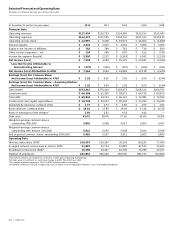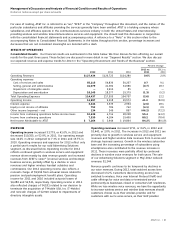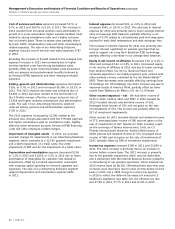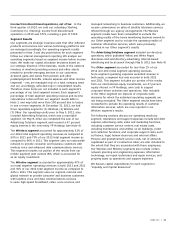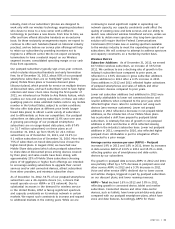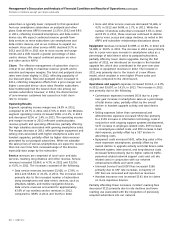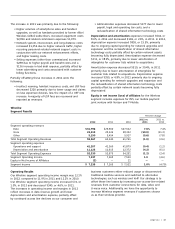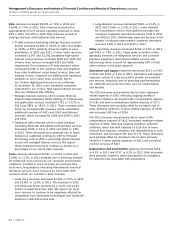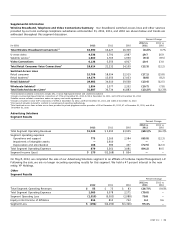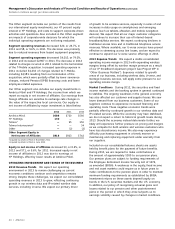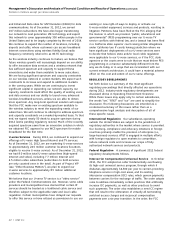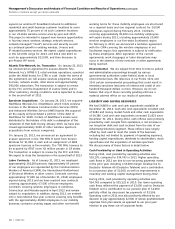AT&T Wireless 2012 Annual Report Download - page 42
Download and view the complete annual report
Please find page 42 of the 2012 AT&T Wireless annual report below. You can navigate through the pages in the report by either clicking on the pages listed below, or by using the keyword search tool below to find specific information within the annual report.
Management’s Discussion and Analysis of Financial Condition and Results of Operations (continued)
Dollars in millions except per share amounts
40 | AT&T Inc.
The Other segment includes our portion of the results from
our international equity investments, our 47 percent equity
interest in YP Holdings, and costs to support corporate-driven
activities and operations. Also included in the Other segment
are impacts of corporate-wide decisions for which the
individual operating segments are not being evaluated.
Segment operating revenues decreased $20, or 26.7%, in
2012 and $8, or 9.6%, in 2011. The decrease was primarily
due to reduced revenues from leased equipment programs.
Segment operating expenses decreased $4,013, or 79.0%,
in 2012 and increased $2,907 in 2011. The decrease in 2012
related to charges incurred in 2011 related to the termination
of the T-Mobile acquisition. Increased operating expense in
2011 included $4,432 of charges related to T-Mobile,
including $4,181 resulting from our termination of the
acquisition, which were partially offset by lower severance
charges, reduced Pension/OPEB financing costs and lower
employee-related expenses.
Our Other segment also includes our equity investments in
América Móvil and YP Holdings, the income from which we
report as equity in net income of affiliates. Our earnings from
foreign affiliates are sensitive to exchange-rate changes in
the value of the respective local currencies. Our equity in
net income of affiliates by major investment is listed below:
2012 2011 2010
América Móvil $686 $720 $560
YP Holdings 130 — —
Telmex1 — 95 150
Telmex Internacional2 — — 34
Other — (2) (2)
Other Segment Equity in
Net Income of Affiliates $816 $813 $742
1Acquired by América Móvil in November 2011.
2Acquired by América Móvil in June 2010.
Equity in net income of affiliates increased $3, or 0.4%, in
2012 and $71, or 9.6%, for 2011. Increased equity in net
income of affiliates in 2012 was due to earnings at
YP Holdings, offset by lower results at América Móvil.
OPERATING ENVIRONMENT AND TRENDS OF THE BUSINESS
2013 Revenue Trends We expect our operating
environment in 2013 to remain challenging as current
economic conditions continue and competition remains
strong. Despite these challenges, we expect our consolidated
operating revenues in 2013 to grow, reflecting continuing
growth in our wireless data and IP-related wireline data
services, including U-verse. We expect our primary driver
of growth to be wireless services, especially in sales of and
increases in data usage on smartphones and emerging
devices (such as tablets, eReaders and mobile navigation
devices). We expect that all our major customer categories
will continue to increase their use of Internet-based
broadband/data services. We expect continuing declines in
traditional access lines and in traditional telephone service
revenues. Where available, our U-verse services have proved
effective in stemming access line losses, and we expect to
continue to expand our U-verse service offerings in 2013.
2013 Expense Trends We expect a stable consolidated
operating income margin in 2013 with expanding wireless
margins being offset by wireline margin pressure as a result
of our IP broadband expansion project (see Project VIP in
“Other Business Matters”). Expenses related to growth
areas of our business, including wireless data, U-verse, and
strategic business services, will apply some pressure to our
operating income margin.
Market Conditions During 2012, the securities and fixed
income markets and the banking system in general continued
to stabilize. The ongoing weakness in the general economy
has also affected our customer and supplier bases. We saw
lower demand from our business customers. Some of our
suppliers continue to experience increased financing and
operating costs. These negative economic trends were
partially offset by continued growth in our wireless data and
IP-related services. While the economy may have stabilized,
we do not expect a return to historical growth levels during
2013. Should the economy instead deteriorate further, we
likely will experience further pressure on pricing and margins
as we compete for both wireline and wireless customers who
have less discretionary income. We also may experience
difficulty purchasing equipment in a timely manner or
maintaining and replacing equipment under warranty from
our suppliers.
Included on our consolidated balance sheets are assets
held by benefit plans for the payment of future benefits.
During 2013, we are required to make contributions in
the amount of approximately $300 to our pension plans.
Our pension plans are subject to funding requirements of
the Employee Retirement Income Security Act of 1974,
as amended (ERISA). A weakness in the equity, fixed income
and real asset markets could require us in future years to
make contributions to the pension plans in order to maintain
minimum funding requirements as established by ERISA.
Investment returns on these assets depend largely on
trends in the U.S. securities markets and the U.S. economy.
In addition, our policy of recognizing actuarial gains and
losses related to our pension and other postretirement
plans in the period in which they arise subjects us to
earnings volatility caused by changes in market conditions.


